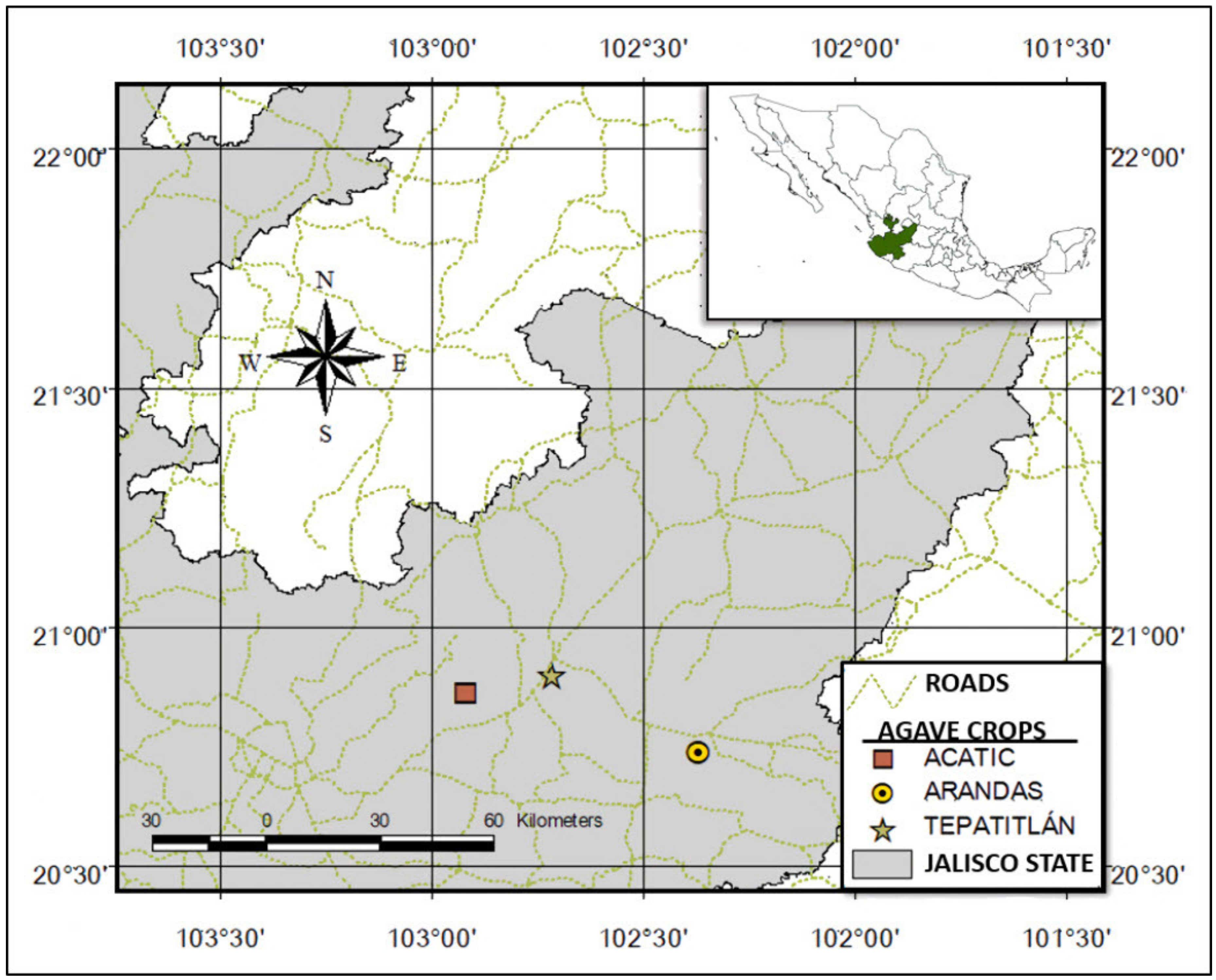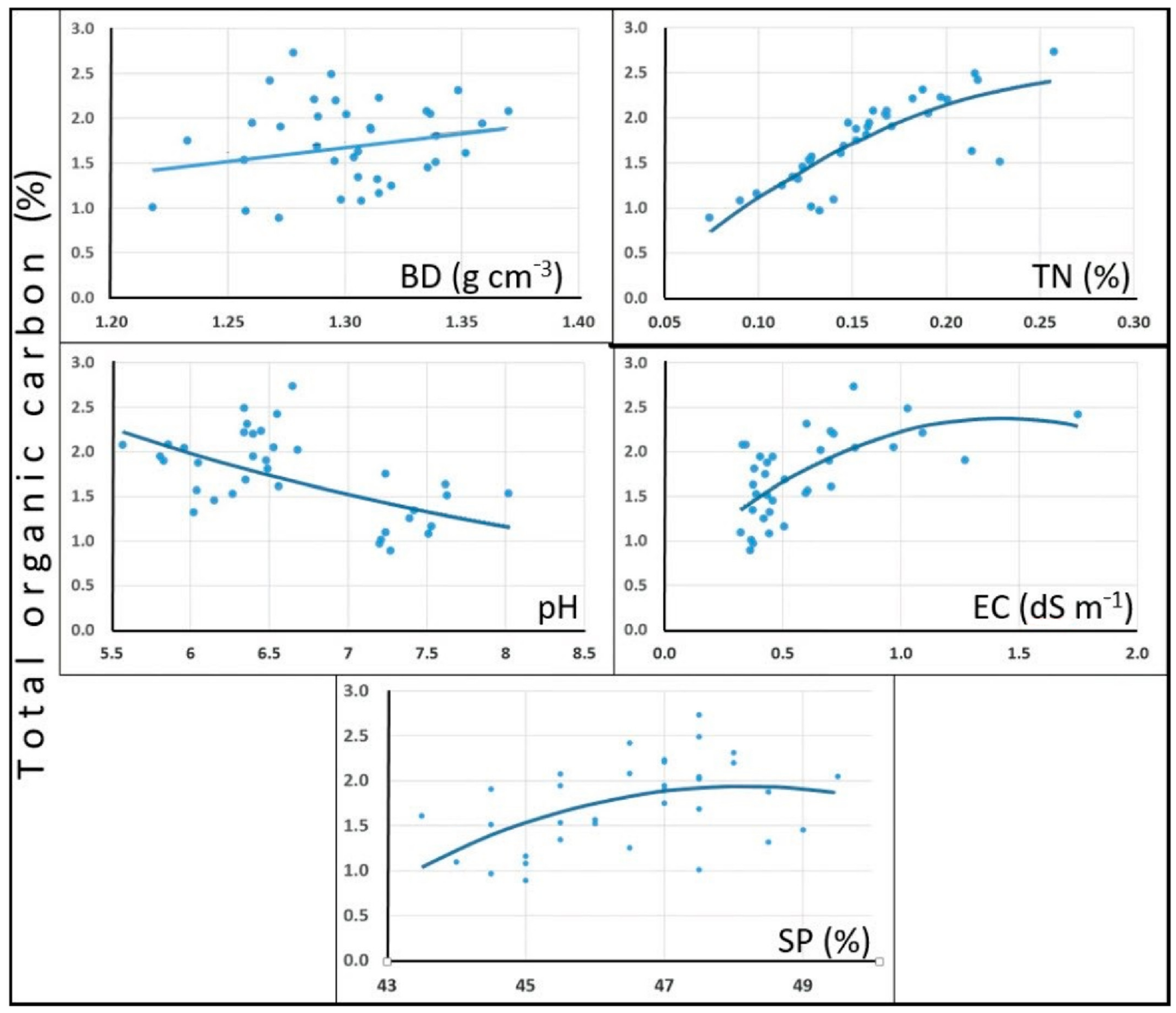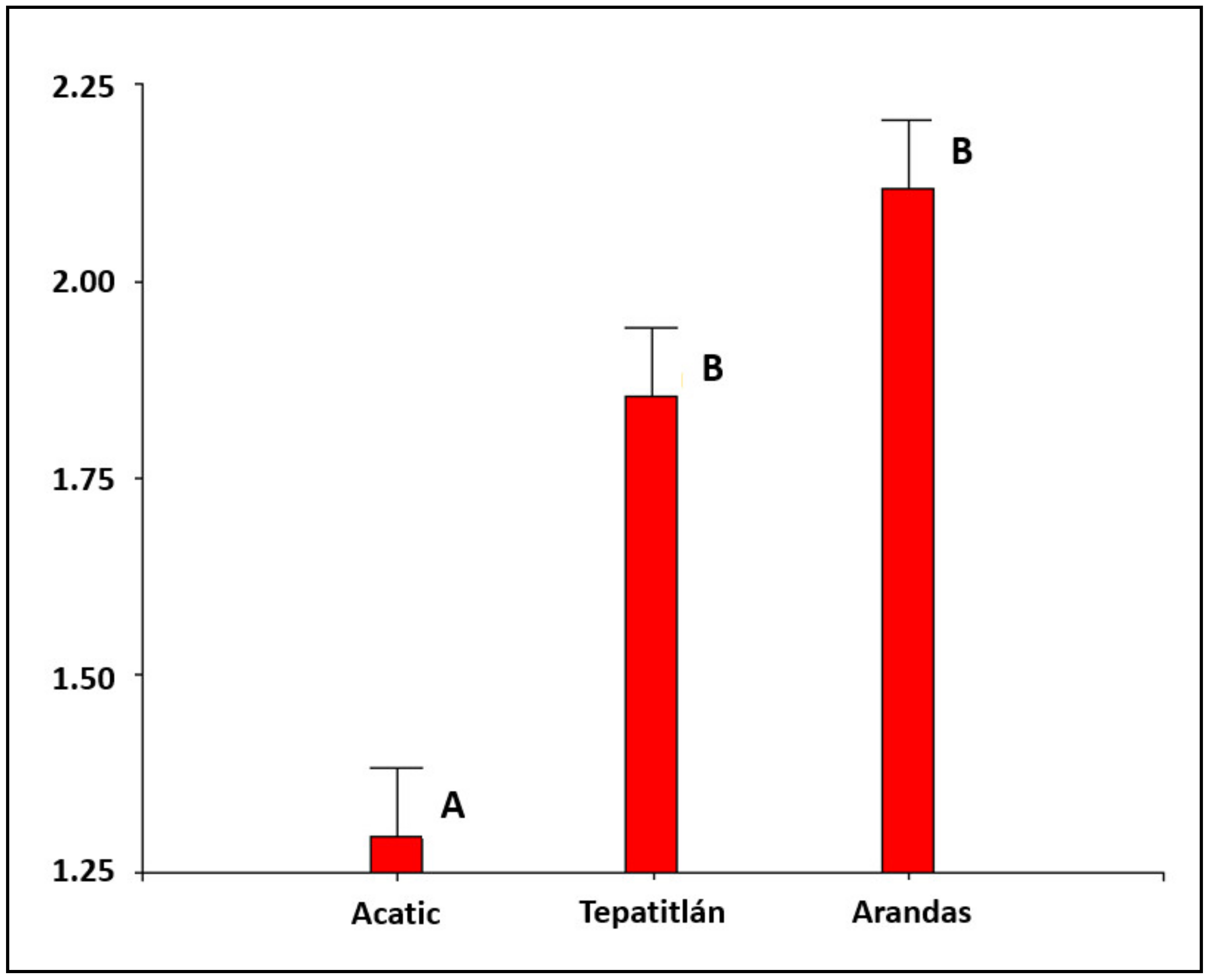Total Organic Carbon Assessment in Soils Cultivated with Agave tequilana Weber in Jalisco, Mexico
Abstract
1. Introduction
2. Materials and Methods
2.1. Study Area
- (a)
- Arandas; application of organic fertilizers every two years before the rainy season (48 ton ha−1 chicken manure) and inorganic fertilizers (Urea, Triple 16, Tropicote, and Nitro max)
- (b)
- Tepatitlán; organic fertilizers once a year before the rainy season (30 ton ha−1 pig manure) and inorganic fertilizers twice per year (Biovida, Earth Black, Phosphito, and Axione)
- (c)
- Acatic; application of inorganic fertilizers twice per year (Triple 16, Potassium, and Nitrogen)
2.2. Soil Sampling
2.3. Data Analysis
3. Results
3.1. Soil Properties
3.2. Soil Nitrogen and Organic Carbon
3.3. Correlations between Parameters
4. Discussion
5. Conclusions
Author Contributions
Funding
Institutional Review Board Statement
Informed Consent Statement
Data Availability Statement
Acknowledgments
Conflicts of Interest
References
- IPCC. Contribución de los Grupos de trabajo I, II y III al Cuarto Informe de evaluación del Grupo Intergubernamental de Expertos sobre el Cambio Climático. Available online: http://finanzascarbono.org/comunidad/pg/file/veronicagutman/read/171709/ (accessed on 7 July 2020).
- Turner, W.R.; Oppenheimer, M.; Wilcove, D.S. A force to fight global warming. Nature 2009, 462, 278–279. [Google Scholar] [CrossRef]
- Jones, H.P.; Hole, D.G.; Zavaleta, E.S. Harnessing nature to help people adapt to climate change. Nat. Clim. Chang. 2012, 2, 504–509. [Google Scholar] [CrossRef]
- Muñoz, T.; Mardones, C. Simulation of a CO2 e tax to mitigate impacts from Chilean agricultural and livestock sectors on climate change. Agrociencia 2016, 50, 271–285. [Google Scholar]
- Lal, R. Soil carbon sequestration impacts on global climate change and food security. Science 2004, 304, 1623–1627. [Google Scholar] [CrossRef] [PubMed]
- Mota, C.; Alcaraz-López, C.; Iglesias, M.; Martínez-Ballesta, M.; Carvajal, M. Absorción de CO2 por los cultivos más representativos de la Región de Murcia. Hortic. Glob. 2011, 294, 58–63. [Google Scholar]
- Blair, N.; Faulkner, R.; Till, A.; Korschens, M.; Schulz, E. Long-term management impacts on soil C, N and physical fertility: Part II: Bad Lauchstadt static and extreme FYM experiments. Soil Tillage Res. 2006, 91, 39–47. [Google Scholar] [CrossRef]
- Blair, N.; Faulkner, R.; Till, A.; Poulton, P. Long-term management impacts on soil C, N and physical fertility: Part I: Broadbalk experiment. Soil Tillage Res. 2006, 91, 30–38. [Google Scholar] [CrossRef]
- Lal, R. Restoring soil quality to mitigate soil degradation. Sustainability 2015, 7, 5875–5895. [Google Scholar] [CrossRef]
- Lal, R. Soil carbon sequestration to mitigate climate change. Geoderma 2004, 123, 1–22. [Google Scholar] [CrossRef]
- Sánchez-Hernández, R.; Ramos-Reyes, R.; Geissen, V.; Mendoza-Palacios, J.D.; Cruz-Lázaro, E.L.; Salcedo-Pérez, E.; Palma-López, D.J. Contenido de carbono en suelos con diferentes usos agropecuarios en el trópico mexicano. Terra Lat. 2011, 29, 211–219. [Google Scholar]
- Singh, Y.G.; Lal, R.; Swaroop, M.R.; Babu, S.; Das, A.; Bhowmik, S.N.; Datta, M.; Layak, J.; Saha, P. Conservation tillage and nutrient management effects on productivity and soil carbon sequestration under double cropping of rice in north Eastern region of India. Ecol. Indic. 2019, 105, 303–315. [Google Scholar]
- Heenan, D.; Chan, K.; Knight, P. Long-term impact of rotation, tillage and stubble management on the loss of soil organic carbon and nitrogen from a Chromic Luvisol. Soil Tillage Res. 2004, 76, 59–68. [Google Scholar] [CrossRef]
- Mandal, B.; Majumder, B.; Bandyopadhyay, P.; Hazra, G.; Gangopadhyay, A.; Samantaray, R.; Mishra, A.; Chaudhury, J.; Saha, M.; Kundu, S. The potential of cropping systems and soil amendments for carbon sequestration in soils under long-term experiments in subtropical India. Glob. Chang. Biol. 2007, 13, 357–369. [Google Scholar] [CrossRef]
- Majumder, B.; Mandal, B.; Bandyopadhyay, P.K.; Gangopadhyay, A.; Mani, P.; Kundu, A.L.; Mazumdar, D. Organic amendments influence soil organic carbon pools and crop productivity in nineteen year old rice-wheat agro-ecosystem. Soil Sci. Soc. Am. J. 2008, 72, 1–11. [Google Scholar] [CrossRef]
- Govaerts, B.; Verhulst, N.; Castellanos-Navarrete, A.; Sayre, K.D.; Dixon, J.; Dendooven, L. Conservation agriculture and soil carbon sequestration: Between myth and farmer reality. Crit. Rev. Plant Sci. 2009, 28, 97–122. [Google Scholar] [CrossRef]
- Teasdale, J.; Coffman, C.; Mangum, R.W. Potential long-term benefits of no-tillage and organic cropping systems for grain production and soil improvement. Agron. J. 2007, 99, 1297–1305. [Google Scholar] [CrossRef]
- De León-González, F.; Hernández-Serrano, M.; Etchevers, J.; Payan-Zelaya, F.; Ordaz-Chaparro, V. Short-term compost effect on macroaggregation in a sandy soil under low rainfall in the valley of Mexico. Soil Tillage Res. 2000, 56, 213–217. [Google Scholar] [CrossRef]
- Stewart, C.E.; Paustian, K.; Conant, R.T.; Plante, A.F.; Six, J. Soil carbon saturation: Concept, evidence and evaluation. Biogeochemistry 2007, 86, 19–31. [Google Scholar] [CrossRef]
- Gulde, S.; Chung, H.; Amelung, W.; Chang, C.; Six, J. Soil carbon saturation controls labile and stable carbon pool dynamics. Soil Sci. Soc. Am. J. 2008, 72, 605–612. [Google Scholar] [CrossRef]
- Pimentel, D.; Hepperly, P.; Hanson, J.; Douds, D.; Seidel, R. Environmental, energetic, and economic comparisons of organic and conventional farming systems. BioScience 2005, 55, 573–582. [Google Scholar] [CrossRef]
- Srinivasarao, C.; Venkateswarlu, B.; Lal, R.; Singh, A.K.; Kundu, S.; Vittal, K.P.R.; Balaguravaiah, G.; Vijaya Shankar Babu, M.; Ravindra Chary, G.; Prasadbabu, M.B.B.; et al. Soil carbon sequestration and agronomic productivity of an Alfisol for a groundnut-based system in a semiarid environment in southern India. Eur. J. Agron. 2012, 43, 40–48. [Google Scholar] [CrossRef]
- Sanderman, J.; Farquharson, R.; Baldock, J. Soil carbon sequestration potential: A Review for Australian Agriculture—A report prepared for the Department of Climate Change and Energy Efficiency CSIRO. Natl. Res. Flagships 2009, 1–81. [Google Scholar]
- Roldán, A.; Salinas-Garcia, J.; Alguacil, M.; Caravaca, F. Changes in soil enzyme activity, fertility, aggregation and C sequestration mediated by conservation tillage practices and water regime in a maize field. Appl. Soil Ecol. 2005, 3, 11–20. [Google Scholar] [CrossRef]
- Báez, M.A.; Aguirre, M.J.F. Efecto de la Labranza de Conservación sobre las propiedades del suelo. Terra Latinoam. 2011, 29, 113–121. [Google Scholar]
- Zamora-Morales, B.; Mendoza-Cariño, M.; Sangerman-Jarquín, D.; Quevedo, A.; Bravo, A. La investigación científica en México: Secuestro de carbono orgánico en suelos agrícolas y de agostadero. Rev. Mex. Cienc. Agríc. 2019, 10, 155–164. [Google Scholar] [CrossRef]
- Semarnat, I. México Quinta Comunicación Nacional Ante la Convención Marco de las Naciones Unidas Sobre el Cambio Climático, 1st ed.; Secretaria de Medio Ambiente y Recursos Naturales: Ciudad de México, Mexico, 2012; p. 396. [Google Scholar]
- Cotler, H.; Martínez, M.; Etchevers, J.D. Carbono orgánico en suelos agrícolas de México: Investigación y políticas públicas. Terra Latinoam. 2016, 34, 125–138. [Google Scholar]
- Salinas-Garcia, J.; Baez-Gonzalez, A.; Tiscareno-Lopez, M.; Rosales-Robles, E. Residue removal and tillage interaction effects on soil properties under rain-fed corn production in Central Mexico. Soil Tillage Res. 2001, 59, 67–69. [Google Scholar] [CrossRef]
- Follett, R.F.; Castellanos, J.Z.; Buenger, E.D. Carbon dynamics and sequestration in an irrigated Vertisol in Central Mexico. Soil Tillage Res. 2005, 83, 148–158. [Google Scholar] [CrossRef]
- González-Molina, L.; Etchevers-Barra, J.; Paz-Pellat, F.; Diaz-Solis, H.; Fuentes-Ponce, M.; Covaleda-Ocon, S.; Pando-Moreno, M. Performance of the RothC-26.3 model in short-term experiments in Mexican sites and systems. J. Agric. Sci. 2011, 149, 415–425. [Google Scholar] [CrossRef]
- Ruíz, C.J.A.; Pimienta, B.E.; Zañudo, H.J. Regiones térmicas óptimas y marginales para el cultivo de Agave tequilana en el estado de Jalisco. Agrociencia 2002, 36, 41–53. [Google Scholar]
- Consejo Regulador Del Tequila, A.C. Información Estadística. CRT. 2020. Available online: https://www.crt.org.mx/EstadisticasCRTweb/. (accessed on 14 July 2020).
- Herrera-Pérez, L.; Juárez-Sánchez, J.; Ramírez-Valverde, B.; Hernández-Placencia, J. El cultivo de Agave tequilana Weber por pequeños productores de Tequila, Jalisco. AGROProductividad 2013, 6, 21–27. [Google Scholar]
- Herrera-Pérez, L.; Valtierra-Pacheco, E.; Ocampo-Fletes, I.; Tornero-Campante, M.A.; Hernández-Plascencia, J.A.; Rodríguez-Macías, R. Prácticas agroecológicas en Agave tequilana Weber bajo dos sistemas de cultivo en Tequila, Jalisco. Rev. Mex. De Cienc. Agrícolas 2017, 8, 3711–3724. [Google Scholar] [CrossRef][Green Version]
- Moreno, A.H.; Estrella, N.; Escobedo, S.; Bustamante, A.; Gerritsen, P. Prácticas de manejo agronómico para la sustentabilidad: Características y medición en Agave tequilana weber en la región Sierra de Amula, Jalisco. Trop. Subtrop. Agroecosys 2011, 4, 159–169. [Google Scholar]
- Medina, G.G.; Ruíz, C.J.A.; Martínez, P.R.A. Los Climas de México: Una Estratificación Ambiental Basada en el Componente Climático, 1st ed.; Instituto Nacional de Investigaciones Forestales, Agrícolas y Pecuarias: Guadalajara, Mexico, 1998; p. 99. [Google Scholar]
- Secretaría de Medio Ambiente Y Recursos Naturales. NOM-021-RECNAT-2000 Especificaciones de Fertilidad, Salinidad y Clasificación de Suelos. Diario Oficial de la Federación, 31 December 2002. Available online: http://dof.gob.mx/nota_detalle.php?codigo=717582&fecha=31/12/2002 (accessed on 21 July 2020).
- Cueto, A.W. Red de laboratorios para el análisis, uso, conservación y manejo del suelo (REDLAB). In Proceedings of the Taller regional de armonización de laboratorios de suelos para América Latina y el Caribe y lanzamiento de la Red Latinoamericana de Laboratorios de Suelos (LATSOLAN), Texcoco, Mexico, 1–3 March 2018. [Google Scholar]
- Castellanos, J.; Uvalle-Bueno, J.; Aguilar-Santelises, A. Manual de Interpretación de Análisis de Suelos y Aguas, 2nd ed.; Instituto de Capacitación para la Productividad Agrícola: Mexico City, Mexico, 2000. [Google Scholar]
- Ruíz, J.; Medina, G.; González, I.; Flores, H.; Ramírez, G.; Ortíz, C.; Byerly, K.; Martínez, R. Requerimientos Agroecológicos de Cultivos, 2nd ed.; Instituto Nacional de Investigaciones Forestales, Agrícolas y Pecuarias: Guadalajara, Mexico, 2013; p. 564. [Google Scholar]
- Martínez, H.E.; Fuentes, J.P.E.; Acevedo, E.H. Carbono orgánico y propiedades del suelo. R. Cienc. Suelo Nutr. Veg. 2008, 8, 68–96. [Google Scholar] [CrossRef]
- Singh, B.K.; Walker, J.A.; Morgan, W.; Wright, D.J. Effect of soil pH on the biodegradation of Chlorpyrifos and isolation of a Chlorpyrifos-Degrading bacterium. Appl. Environ. Microbiol. 2003, 69, 5198–5206. [Google Scholar] [CrossRef]
- Geissen, V.; Morales, G. Fertility of tropical soils under different land use systems-a case of study of soils in Tabasco, México. Appl. Soil Ecol. 2006, 31, 169–178. [Google Scholar] [CrossRef]
- Antúnez, B.A.; Felmer, E.S.; Vidal, S.M.; Morales, J.R.; Coz, L.E.; Fuentes, F.F. Propiedades Físico-Hídricas del Suelo en el Cultivo del Maíz Grano. In Riego por Pulsos en Maíz Grano, 1st ed.; Instituto de Investigaciones Agropecuarias: Rengo, Chile, 2015; pp. 31–50. [Google Scholar]
- Halvorson, A.D.; Reule, C.A.; Follett, R.F. Nitrogen fertilization effects on soil carbon and nitrogen in a dryland cropping system. Soil Sci. Soc. Am. J. 1999, 63, 912–917. [Google Scholar] [CrossRef]
- Du, Z.; Liu, S.; Li, K.; Ren, T. Soil organic carbon and physical quality as influenced by long-term application of residue and mineral fertilizer in the North China Plain. Soil Res. 2009, 47, 585–591. [Google Scholar] [CrossRef]
- Srinivasarao, C.; Deshpande, A.; Venkateswarlu, B.; Lal, R.; Singh, A.K.; Kundu, S.; Vittal, K.; Mishra, P.; Prasad, J.; Mandal, U. Grain yield and carbon sequestration potential of post monsoon sorghum cultivation in Vertisols in the semiarid tropics of central India. Geoderma 2012, 175, 90–97. [Google Scholar] [CrossRef]
- Frey, S.D.; Ollinger, S.; Nadelhoffer, K.E.; Bowden, R.; Brzostek, E.; Burton, A.; Caldwell, B.; Crow, S.; Goodale, C.L.; Grandy, A.S. Chronic nitrogen additions suppress decomposition and sequester soil carbon in temperate forests. Biogeochemistry 2014, 121, 305–316. [Google Scholar] [CrossRef]
- Windeatt, J.H.; Ross, A.B.; Williams, P.T.; Forster, P.M.; Nahil, M.A.; Singh, S. Characteristics of biochars from crop residues: Potential for carbon sequestration and soil amendment. J. Environ. Manag. 2014, 146, 189–197. [Google Scholar] [CrossRef] [PubMed]
- Nayak, A.; Gangwar, B.; Shukla, A.K.; Mazumdar, S.P.; Kumar, A.; Raja, R.; Kumar, A.; Kumar, V.; Rai, P.; Mohan, U. Long-term effect of different integrated nutrient management on soil organic carbon and its fractions and sustainability of rice–wheat system in Indo Gangetic Plains of India. Field Crop. Res. 2012, 127, 129–139. [Google Scholar] [CrossRef]
- Álvarez, R. A review of nitrogen fertilizer and conservation tillage effects on soil organic carbon storage. Soil Use Manag. 2005, 21, 38–52. [Google Scholar] [CrossRef]
- Poirier, V.; Angers, D.A.; Rochette, P.; Chantigny, M.H.; Ziadi, N.; Tremblay, G.; Fortin, J. Interactive effects of tillage and mineral fertilization on soil carbon profiles. Soil Sci. Soc. Am. J. 2009, 73, 255–261. [Google Scholar] [CrossRef]




| Characteristics | Arandas | Tepatitlán | Acatic |
|---|---|---|---|
| Geographical location | 20° 39′ 59.5″ N 102° 22′ 02.0″ W | 20° 51′ 03.8″ N 102° 42′ 59.8″ W | 20° 48′ 15.6″ N 102° 55′ 08.8″ W |
| Elevation (masl) | 1670–2370 | 1270–1806 | 1164–2270 |
| Climate | Semi-warm Semi-humid | Semi-warm Semi-humid | Semi-warm Semi-humid |
| Average anual temperature (°C) | 17.3 | 17.8 | 18.7 |
| Tmax (°C) | 30.2 | 29.1 | 30.7 |
| Tmin (°C) | 5.4 | 5.8 | 6.2 |
| Rainfall (mm) | 919 | 868 | 900 |
| WRB | Vertisol | Luvisol | Luvisol |
| Parameter | Method | Equipment |
|---|---|---|
| pH | Potenciometer | |
| Electrical conductivity (dSm−1) | NOM-021-RECNAT-2000 (AS-02) [38] | Potenciometer |
| Saturation point (%) | Saturation column | |
| Bulk density (g cm−3) | Richards graduated cylinder method | 50 mL graduated cylinder |
| Total nitrogen (%) | Protocol proposed by the Red Nacional de Laboratorios para el análisis, uso, conservación y manejo del suelo [39] | Automated elemental analyzer with a thermal conductivity detector. |
| Total organic carbon (%) | Thermo Scientific (Flash 2000) |
| Parameter | Location | ||
|---|---|---|---|
| Arandas | Tepatitlán | Acatic | |
| pH | 6.146 (±0.344) | 6.366 (±0.205) | 7.440 (±0.241) |
| Electrical conductivity (dSm−1) | 0.294 (±0.187) | 0.271 (±0.123) | 0.153 (±0.037) |
| Bulk density (g cm−3) | 1.311 (±0.035) | 1.310 (±0.026) | 1.285 (±0.038) |
| Soil-water saturation (%) | 47.00 (±0.356) | 45.167 (±2.596) | 18.27 (±1.376) |
| Total nitrogen (%) | 0.174 (±0.023) | 0.164 (±0.041) | 0.135 (±0.046) |
| Total organic carbon (%) | 2.109 (±0.035) | 1.840 (±0.035) | 1.269 (±0.035) |
| Variable | Model | Equation | R2 |
|---|---|---|---|
| BD | Potential | TOC = 0.8863 × BD 2.4127 | 0.0501 |
| TN | Polynomial | TOC = (−35.066 × TN2) + (20.75 × TN) − 0.6018 | 0.6806 |
| pH | Exponential | TOC = 9.459 e(−0.26 × pH) | 0.3276 |
| EC | Polynomial | TOC = (−0.8322 × EC2) + (2.3723 × EC) + 0.6931 | 0.4099 |
| SP | Polynomial | TOC = (−0.0415 × SP2) + (3.9953 × SP) − 94.249 | 0.2420 |
| TOC | EC | SP | BD | TN | pH | |
|---|---|---|---|---|---|---|
| TOC | 1.00 | 1.60 × 10−4 | 0.010 | 0.31 | 2.40 × 10−9 | 5.20 × 10−4 |
| EC | 0.59 | 1.00 | 0.38 | 0.35 | 1.70 × 10−3 | 0.26 |
| SP | 0.44 | 0.16 | 1.00 | 0.63 | 0.09 | 0.01 |
| BD | 0.17 | −0.16 | 0.09 | 1.00 | 0.57 | 0.06 |
| TN | 0.81 | 0.51 | 0.29 | 0.100 | 1.00 | 0.22 |
| pH | −0.55 | −0.19 | −0.43 | −0.31 | −0.21 | 1.00 |
| Variable | Value | Standard Error | t Value | Pr (>|t|) |
|---|---|---|---|---|
| Intercept | −0.3285 | 2.1998 | −0.1493 | 0.8824 |
| pH | −0.2200 | 0.0670 | −3.2850 | 0.0027 |
| EC | 0.2869 | 0.1408 | 2.0371 | 0.0512 |
| SP | 0.0340 | 0.0266 | 1.2774 | 0.2120 |
| AD | 0.486 | 1.1018 | 0.4411 | 0.6625 |
| TN | 7.3064 | 1.1038 | 6.6190 | 0.0000 |
| AIC | Variables |
|---|---|
| 1.6235 | pH + EC + SP + BD + TN |
| 1.5502 | pH + EC + SP + TN |
| 1.5323 | pH + EC + TN |
| Variable | Value | Standard Error | t Value | Pr (>|t|) |
|---|---|---|---|---|
| Intercept | 2.1099 | 0.4491 | 4.6986 | 0.0001 |
| pH | −0.2595 | 0.0583 | 4.4496 | 0.0001 |
| EC | 0.2679 | 0.1356 | 1.9764 | 0.0574 |
| TN | 7.6172 | 1.0699 | 7.1196 | 0.0000 |
| Variance Factor | SS | df | MS | F | p Value |
|---|---|---|---|---|---|
| Model | 4.42 | 2.00 | 2.21 | 23.29 | <0.0001 |
| Site | 4.42 | 2.00 | 2.21 | 23.29 | <0.0001 |
| Error | 3.13 | 33.0 | 0.09 | ||
| Total | 7.55 | 35.0 |
Publisher’s Note: MDPI stays neutral with regard to jurisdictional claims in published maps and institutional affiliations. |
© 2020 by the authors. Licensee MDPI, Basel, Switzerland. This article is an open access article distributed under the terms and conditions of the Creative Commons Attribution (CC BY) license (http://creativecommons.org/licenses/by/4.0/).
Share and Cite
De La Mora-Orozco, C.; Flores-Garnica, J.G.; Vega-Ramírez, L.M.; González-Acuña, I.J.; Nápoles-Armenta, J.; Martínez-Orozco, E. Total Organic Carbon Assessment in Soils Cultivated with Agave tequilana Weber in Jalisco, Mexico. Sustainability 2021, 13, 208. https://doi.org/10.3390/su13010208
De La Mora-Orozco C, Flores-Garnica JG, Vega-Ramírez LM, González-Acuña IJ, Nápoles-Armenta J, Martínez-Orozco E. Total Organic Carbon Assessment in Soils Cultivated with Agave tequilana Weber in Jalisco, Mexico. Sustainability. 2021; 13(1):208. https://doi.org/10.3390/su13010208
Chicago/Turabian StyleDe La Mora-Orozco, Celia, José G. Flores-Garnica, Lucia M. Vega-Ramírez, Irma J. González-Acuña, Juan Nápoles-Armenta, and Edgardo Martínez-Orozco. 2021. "Total Organic Carbon Assessment in Soils Cultivated with Agave tequilana Weber in Jalisco, Mexico" Sustainability 13, no. 1: 208. https://doi.org/10.3390/su13010208
APA StyleDe La Mora-Orozco, C., Flores-Garnica, J. G., Vega-Ramírez, L. M., González-Acuña, I. J., Nápoles-Armenta, J., & Martínez-Orozco, E. (2021). Total Organic Carbon Assessment in Soils Cultivated with Agave tequilana Weber in Jalisco, Mexico. Sustainability, 13(1), 208. https://doi.org/10.3390/su13010208







